Cisco Evolved Programmable Network Manager
Available Languages
Bias-Free Language
The documentation set for this product strives to use bias-free language. For the purposes of this documentation set, bias-free is defined as language that does not imply discrimination based on age, disability, gender, racial identity, ethnic identity, sexual orientation, socioeconomic status, and intersectionality. Exceptions may be present in the documentation due to language that is hardcoded in the user interfaces of the product software, language used based on RFP documentation, or language that is used by a referenced third-party product. Learn more about how Cisco is using Inclusive Language.
The Cisco® Evolved Programmable Network (EPN) Manager is an all-in-one management solution for today’s converged packet and optical networks.
The Cisco Evolved Programmable Network (EPN) Manager is an all-in-one management solution for today’s converging packet and optical networks and it is an integral component of the Cisco Routed Optical Network automation.
This next-generation product provides device management, network service provisioning, and network assurance across core, edge, aggregation, and access networks consisting of a wide range of Cisco device families, as illustrated below.


Network scope
Graphical user interface: The rich set of device and network management functions is easily accessible to network operators via a graphical user interface. The following subsections use screenshots of the graphical user interface to illustrate the device and network management functions. The usual home screen of the Cisco EPN Manager is a dashboard view that users can configure to display key information to summarize the status of the network. Users can add, remove, and configure dashlets to suit their needs for a quick view of the network when first logging in.
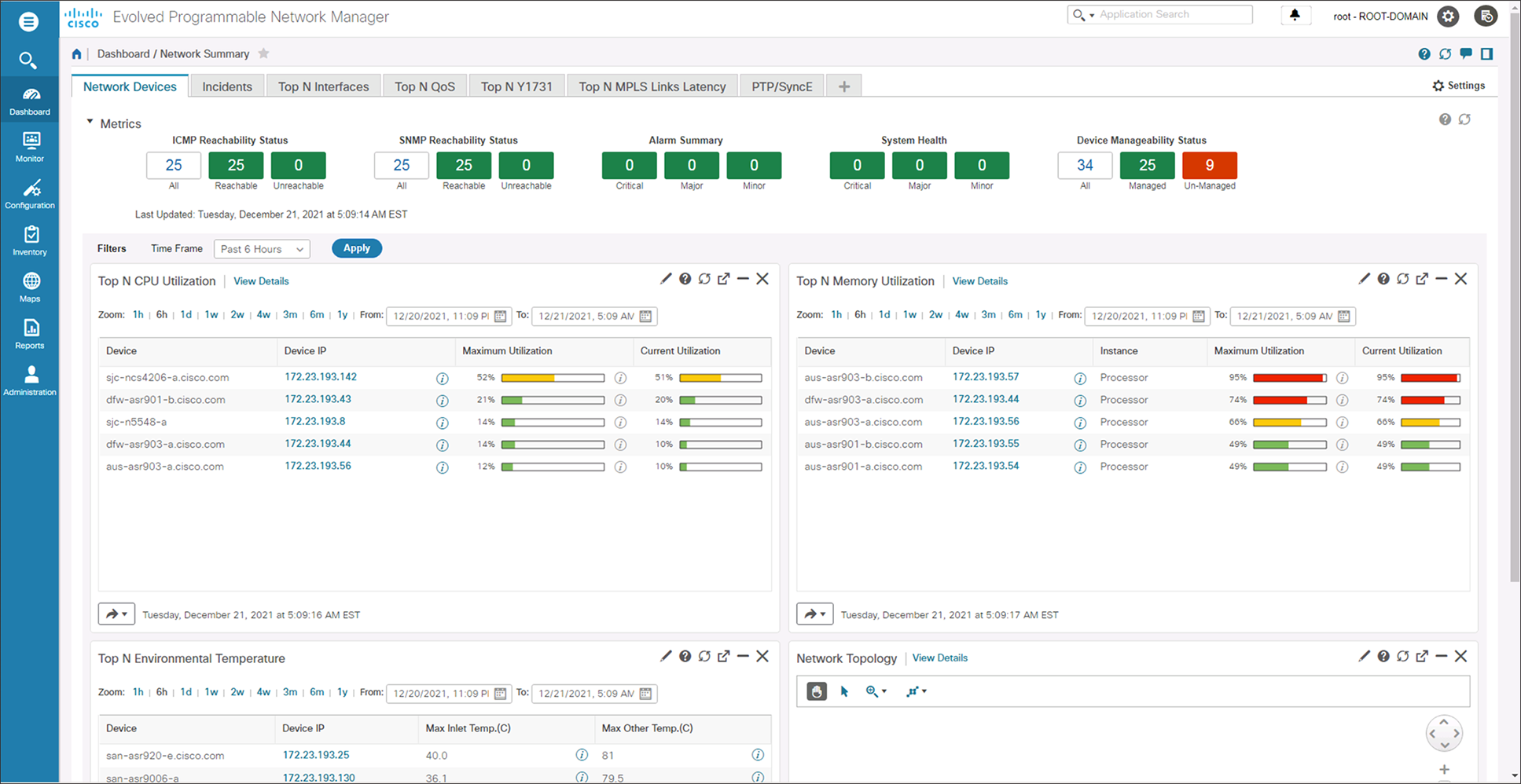
Cisco EPN Manager dashboard home screen
From the home screen, network operators can navigate to device and network management functions via the main menu or drill into specific information from one of the displayed dashboards.
| Benefit |
Description |
| Operation efficiency |
● A unified user interface that combines optical and packet network services to provide a single, intuitive structure for accessing tasks and operations
● Converged network management information and functions for streamlined task flows traversing provisioning, assurance, and device management functions
● Contextual dashboards and 360-degree user and device views display only the most relevant information for fast and efficient troubleshooting and remediation
|
| Improved operations and management |
● Built-in high availability increases uptime for services delivery and improves operation efficiency; ready-to-use support for high availability enables devices to call home in the event of failover
● Ongoing support for Cisco devices and software releases helps ensure device support parity within each device family and is provided through device packs
● New technology packs deliver new features between releases without requiring an upgrade
● Flexible virtual machine- or appliance-based deployment models promote easy setup for quick time to value in global service provider networks
|
| Simplified administration |
● This single-pane solution provides complete end-to-end infrastructure management, reducing the need for multiple tools and lowering operating expenses and training costs
● A consistent user experience provides transparent management (service creation, node provisioning, assurance testing, and troubleshooting) across different parts of the network
|
Multitechnology/Multidomain lifecycle management
The Cisco EPN Manager provides converged element and network management of Carrier Ethernet, Layer 3 MPLS VPN, optical transport, and circuit emulation over packet networks. For example, addressing the combination of Time-Division Multiplexing (TDM) to IP, Optical Transport Network (OTN), and DWDM/ROADM networks provides comprehensive network management support as service providers modernize circuit transport and private line networks.
The following figure outlines the element and network management scope in terms of the manageability cycle offered by the Cisco EPN Manager.
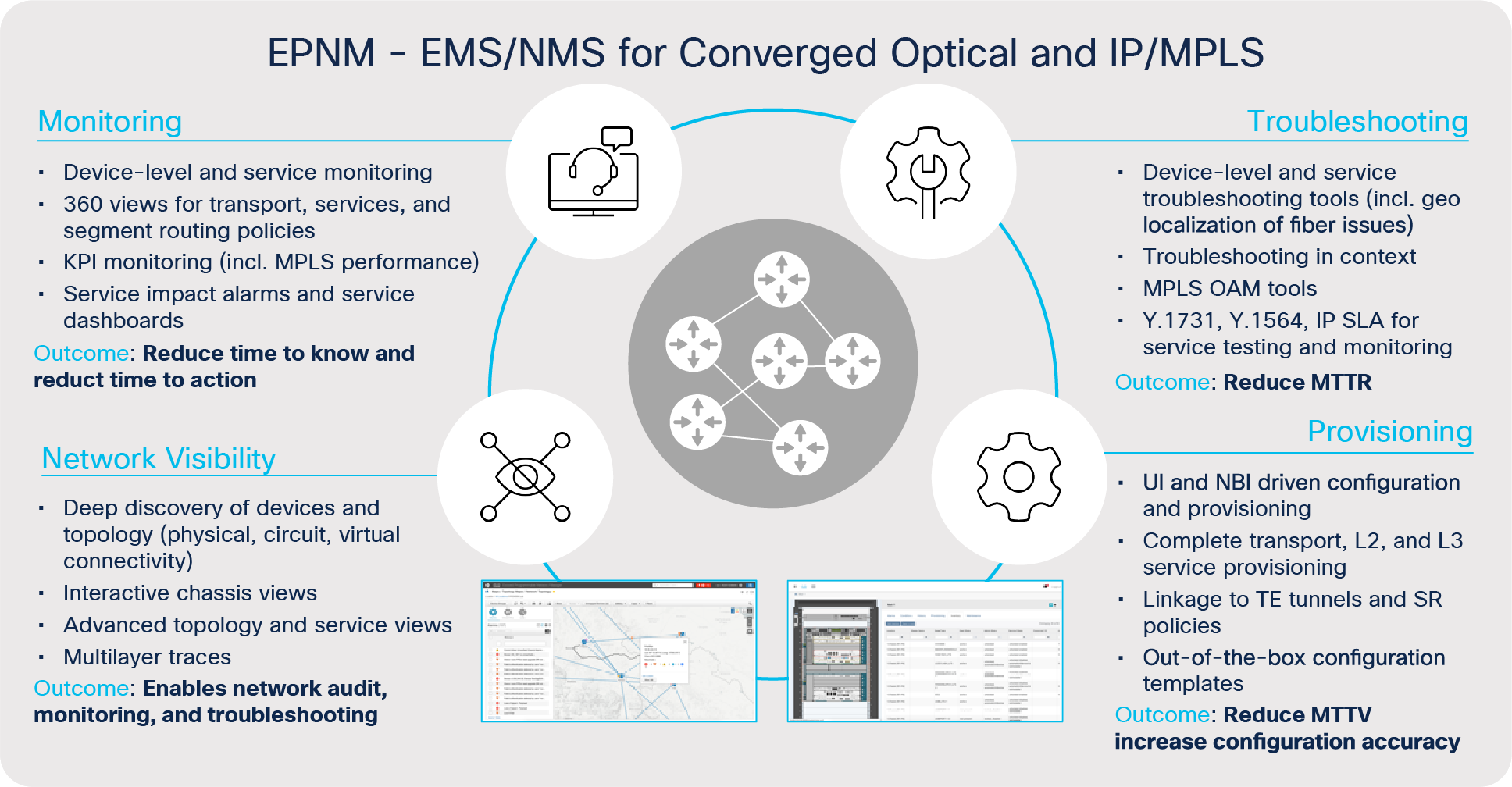
Multitechnology/multidomain lifecycle management
Provisioning: The Cisco EPN Manager helps reduce time to service and, thereby, time to value via point-and-click, wizard-driven provisioning features for end-to-end provisioning flows. Using simplified, end-to-end, point-and-click service provisioning across Layers 0 through 3, services can be easily created and visualized, and human errors can be avoided. Using the RESTCONF API, external applications can programmatically instruct the Cisco EPN Manager to activate network services.
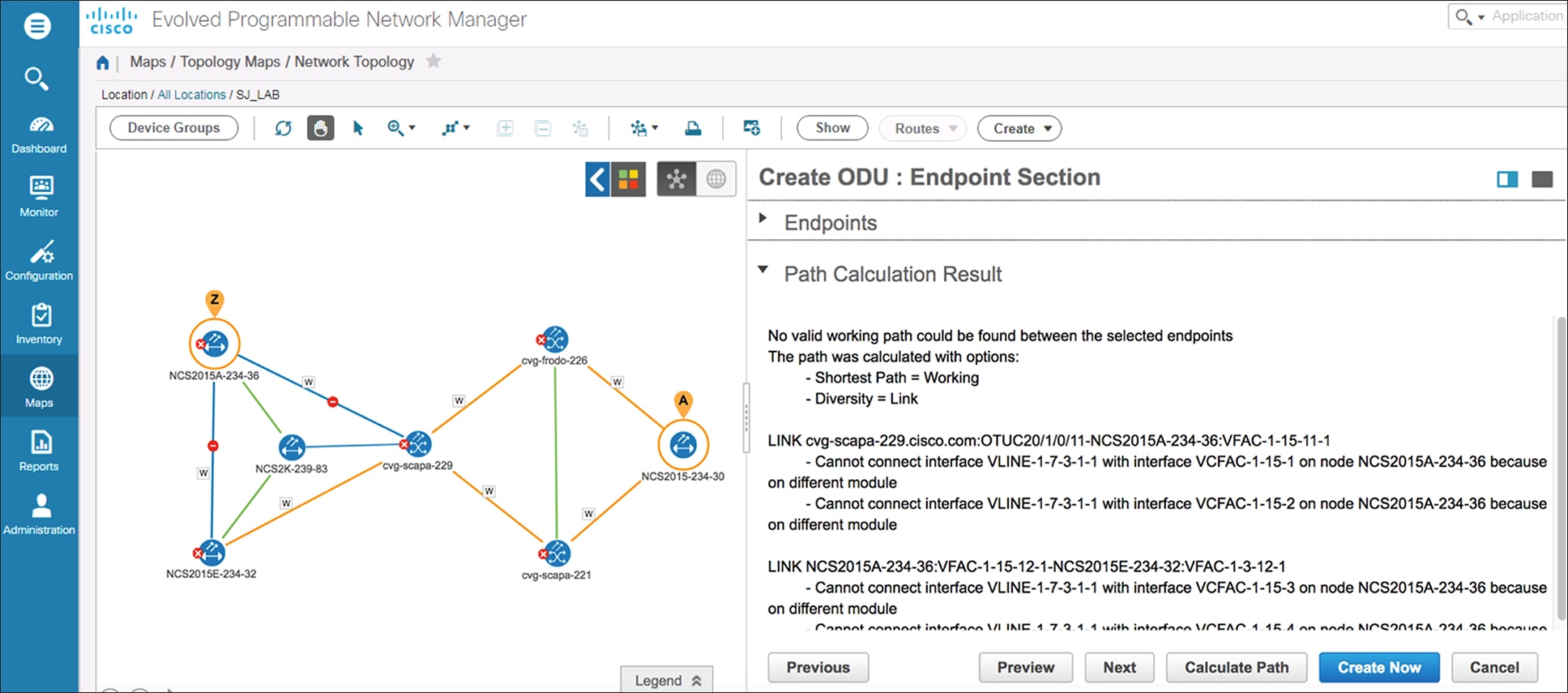
Wizard-driven, easy-to-use, point-and-click provisioning
For updating network element configurations without having to resort to command-line access, the EPN Manager offers two methods.
1. Inline configuration update: Frequently used configurations can be modified via configuration table displays. Users can edit configuration attributes and instruct the EPN Manager to save these edits to the network element. The following example illustrates updating an OSPF router configuration.
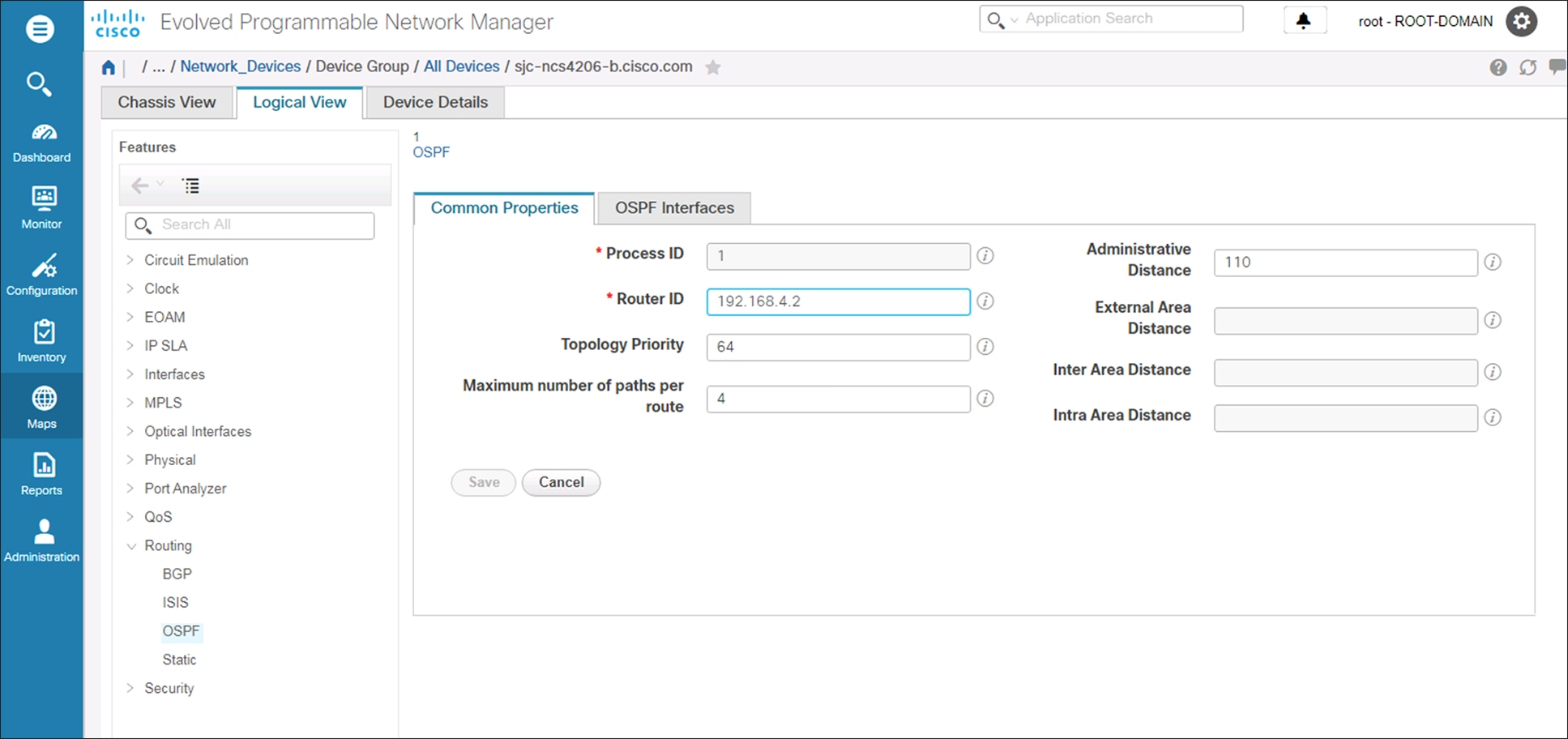
Cisco EPN Manager inline network element configuration update
2. Template: Augmenting the inline configuration update method above is the EPN Manager’s template feature. Users such as network administrators familiar with the network element Command-Line Interface (CLI) can create templates of device commands that can be used over and over again. Users applying these templates do not need to know the CLI commands encapsulated within a given template. Templates can be created with variable attributes so that a given template can be applied to different devices or used in different situations. When a user invokes such a template, the user is prompted to supply values for any variable attribute defined within that template. The EPN Manager provides a number of ready-to-use configuration templates that can be used to make changes on your network elements. These out-of-the-box templates can also be copied and then modified to match specific configuration needs.
Network operators will also be able to leverage the Cisco EPN Manager for routine device administration tasks for Cisco devices that are typically found in service provider and enterprise networks. The Cisco EPN Manager simplifies managing and upgrading Cisco IOS® XR/XE software images with features such as image prerequisite checking, scheduling the distribution of images across the network, scheduling activation of previously distributed images, and tracking what images are active on what devices.
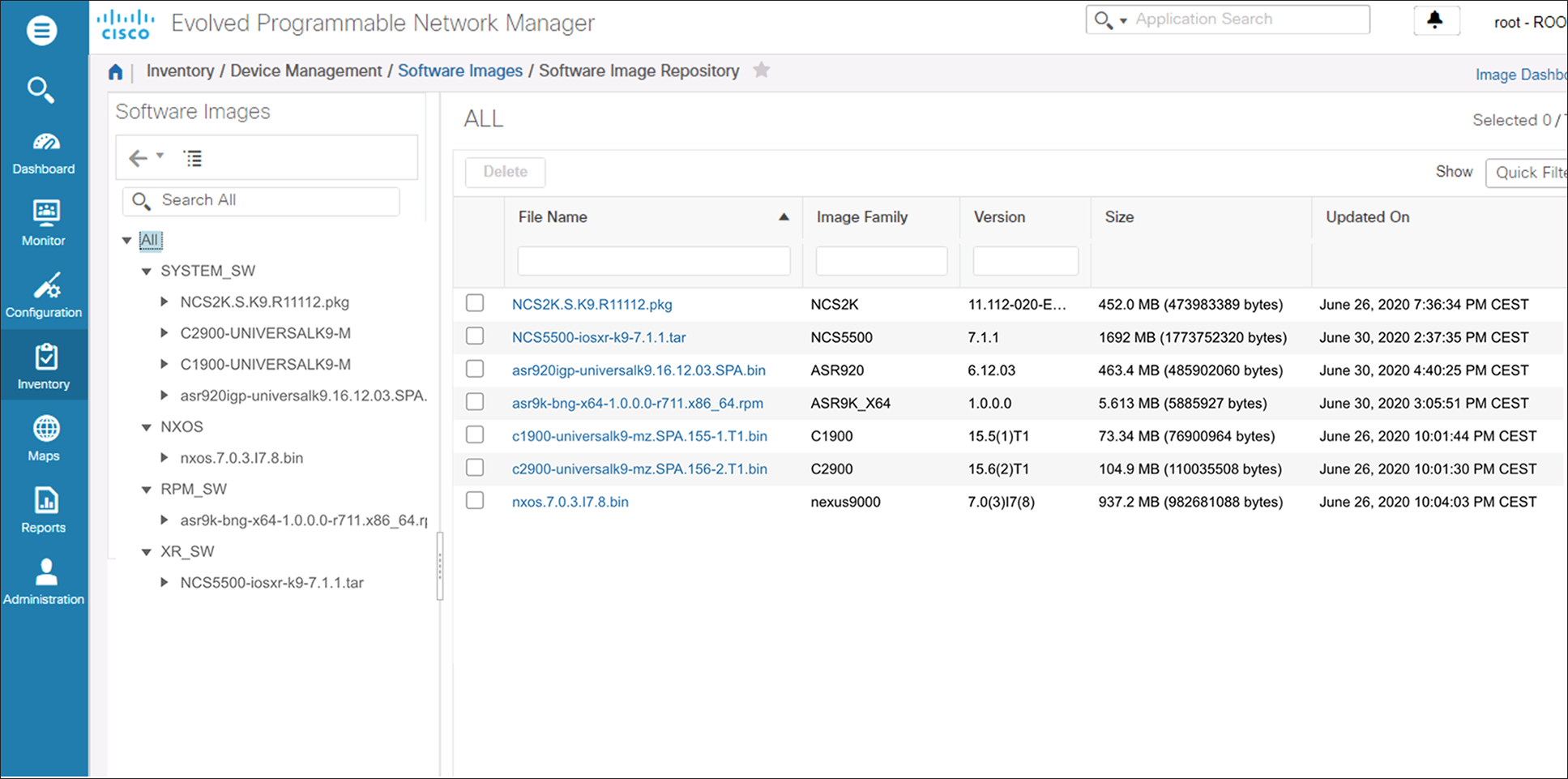
Cisco EPN Manager software image management
Network operators can use the Cisco EPN Manager to streamline routine configuration file/database archive and restoration operations via the methods to schedule backups, to maintain and review archived configuration files, and to restore archived configurations to devices. The Cisco EPN Manager can be configured to automatically archive configuration files/databases. Also available via the Cisco EPN Manager, network operators can schedule configuration compliance audits against “golden” configurations for Cisco IOS XR/XE device families. The compliance feature uses device configuration baselines and audit policies to find and correct any configuration deviations in network elements.
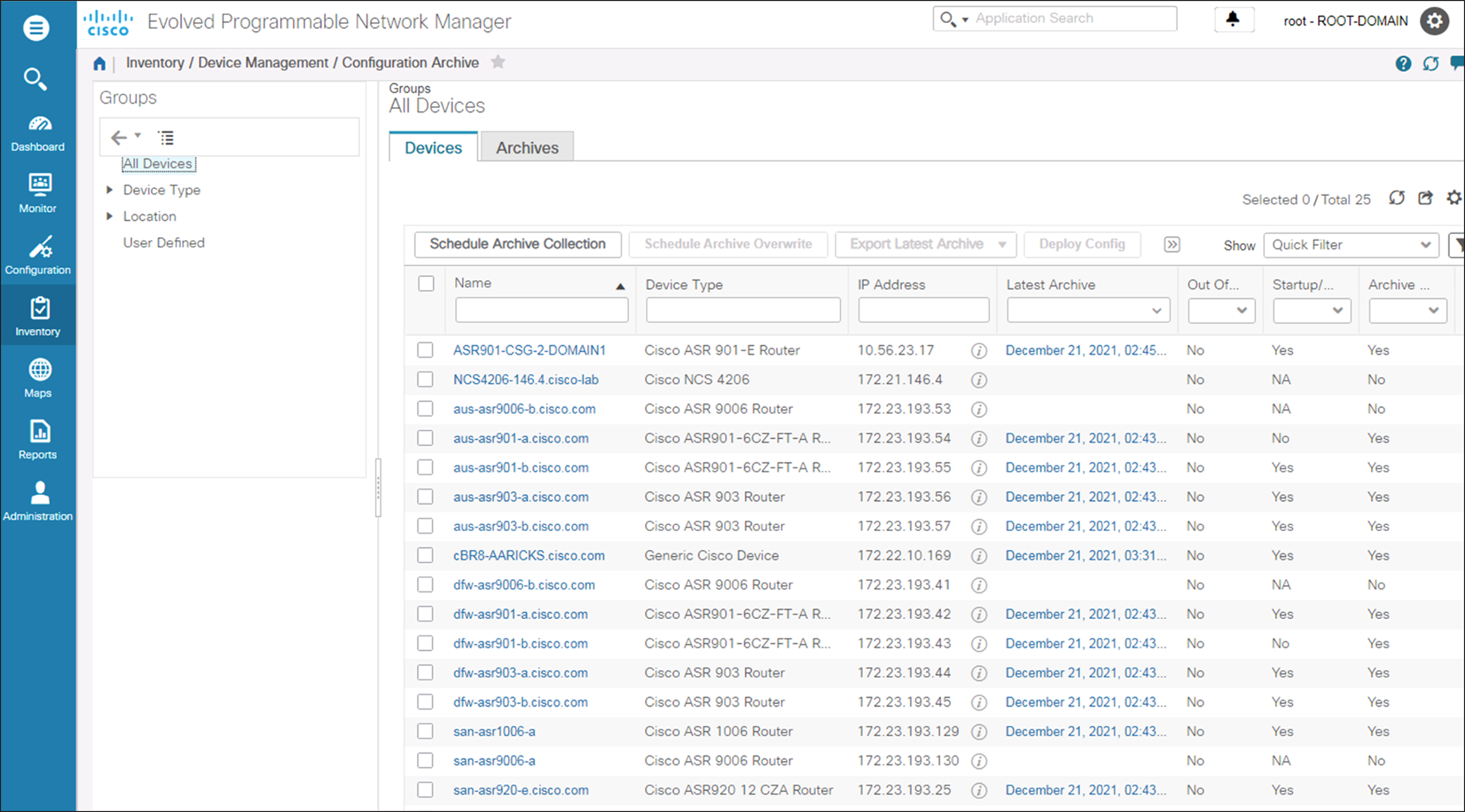
Cisco EPN Manager configuration file management
Network visibility: Accurate troubleshooting depends on detailed information about the managed network elements and network services. The Cisco EPN Manager discovers and represents the physical and logical configuration of managed devices. A graphical chassis view with status indications gives network operators a live-live view of the device.
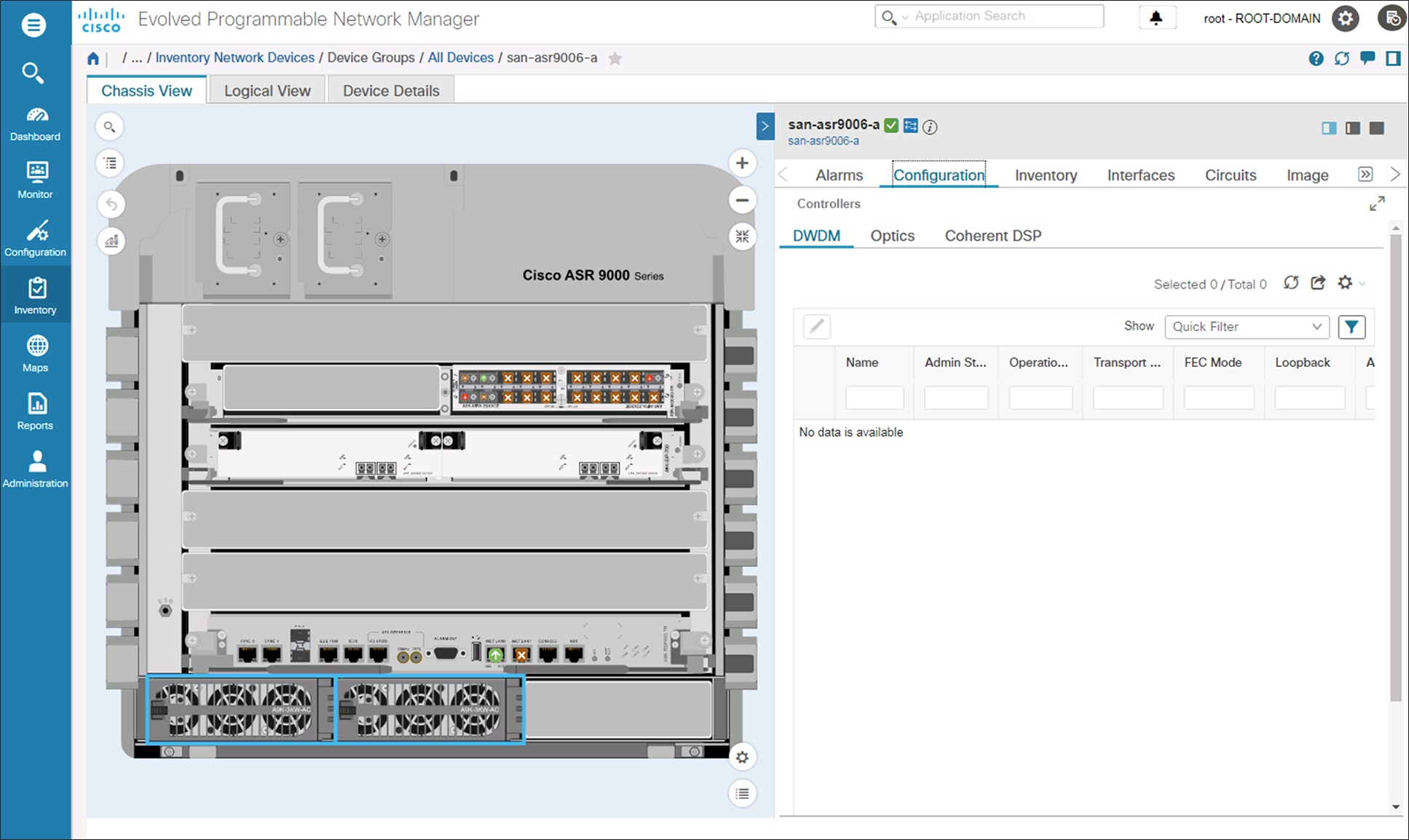
Device management via chassis view
The chassis view is the typical starting point in the EPN Manager’s GUI for other network element operations, such as device-level configurations, device status views, and device-level troubleshooting. The chassis view provides a pictorial representation of a network element and its components. Overlaid on the chassis view are status indicators to help a user focus in on affected components or interfaces. This physical representation greatly facilitates the communication between the operations center and onsite operations staff during onsite repair activities.

Cisco EPN Manager chassis view for multichassis shelf view (available for the NCS 2000 family of devices)
The Cisco EPN Manager differentiates itself from other network management systems with the ability to discover network services from the network and maintain an up-to-date representation of the network services. The network service discovery eases the introduction of Cisco EPN Manager into an existing network. EPN Manager can also serve as a verification mechanism for provisioning actions. Network services, including L2VPNs, L3VPN, EVPN,, OTN, and DWDM circuits, TDM2IP emulated circuits, and infrastructure tunnels such as Segment Routing TE, MPLS TE, Flex-LSP, and Pseudowire tunnels can be represented as topology overlays on geographic maps or, for detailed troubleshooting, via a graphical circuit trace.
At the control plane level, the Cisco EPN Manager discovers and maintains representations of protocol neighbor associations across the network, including IS-IS, OSPF, BGP, and LDP connectivity.
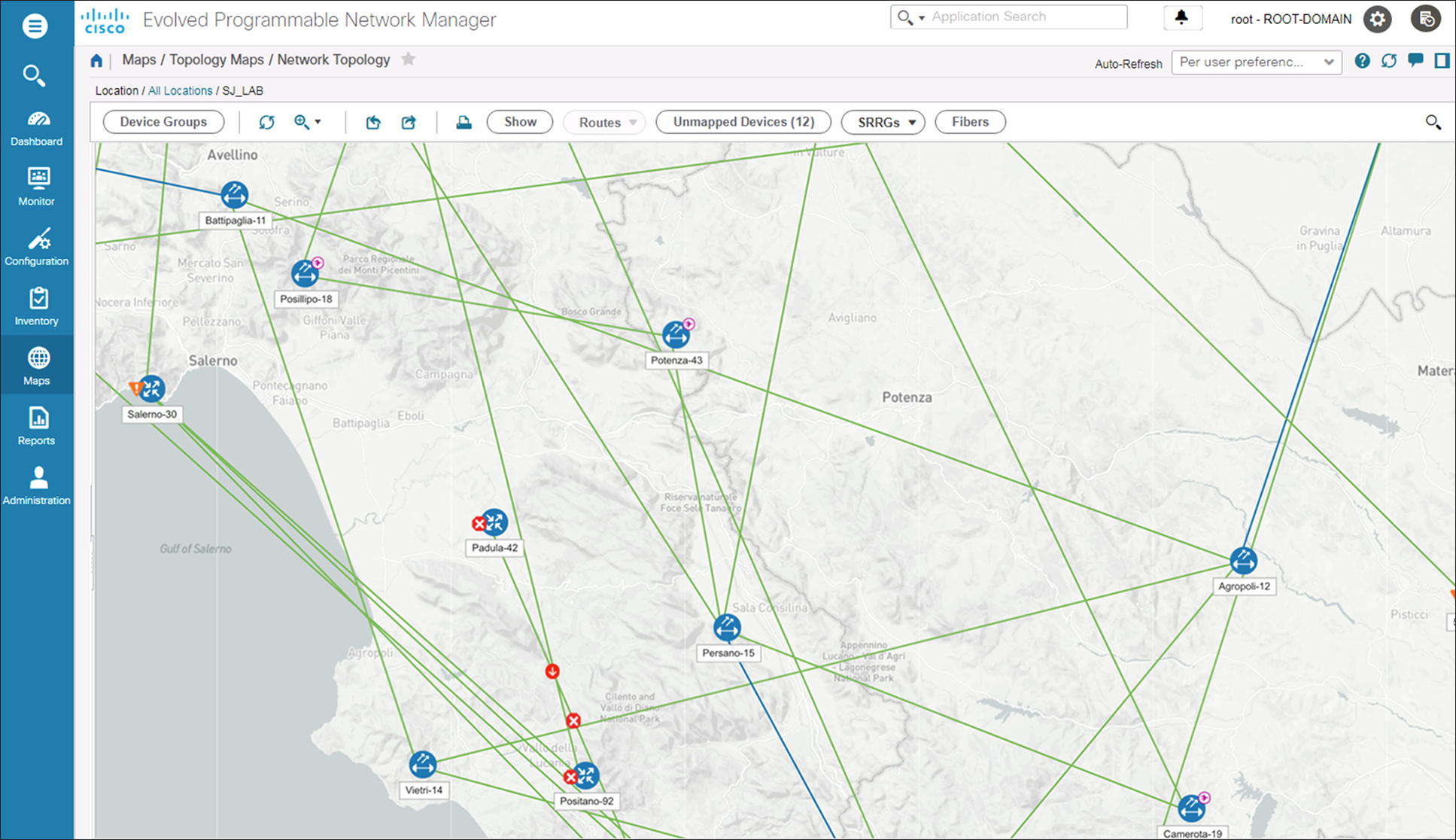
Geographic network topology map
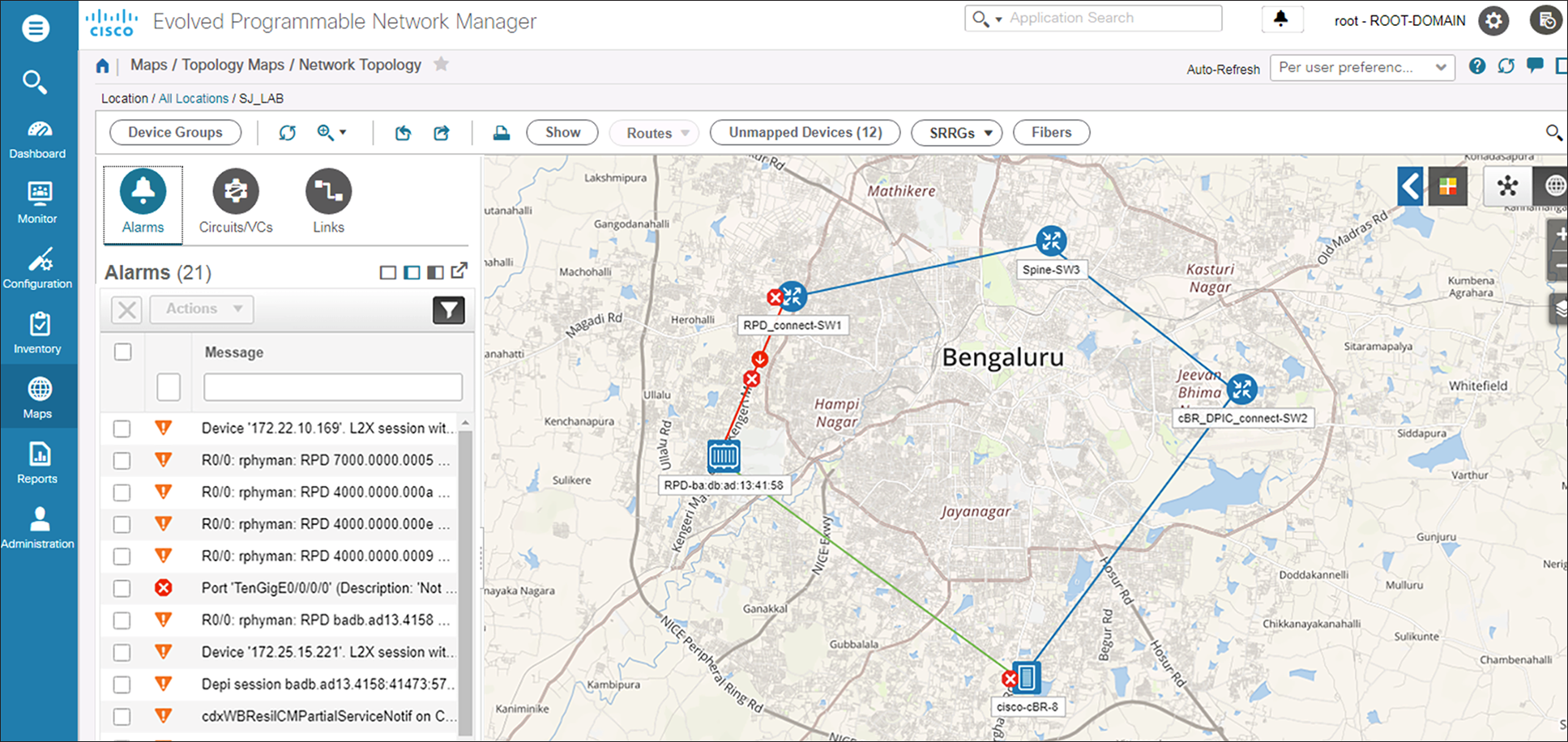
Cisco EPN Manager geographic network topology map with physical and logical topology and link status
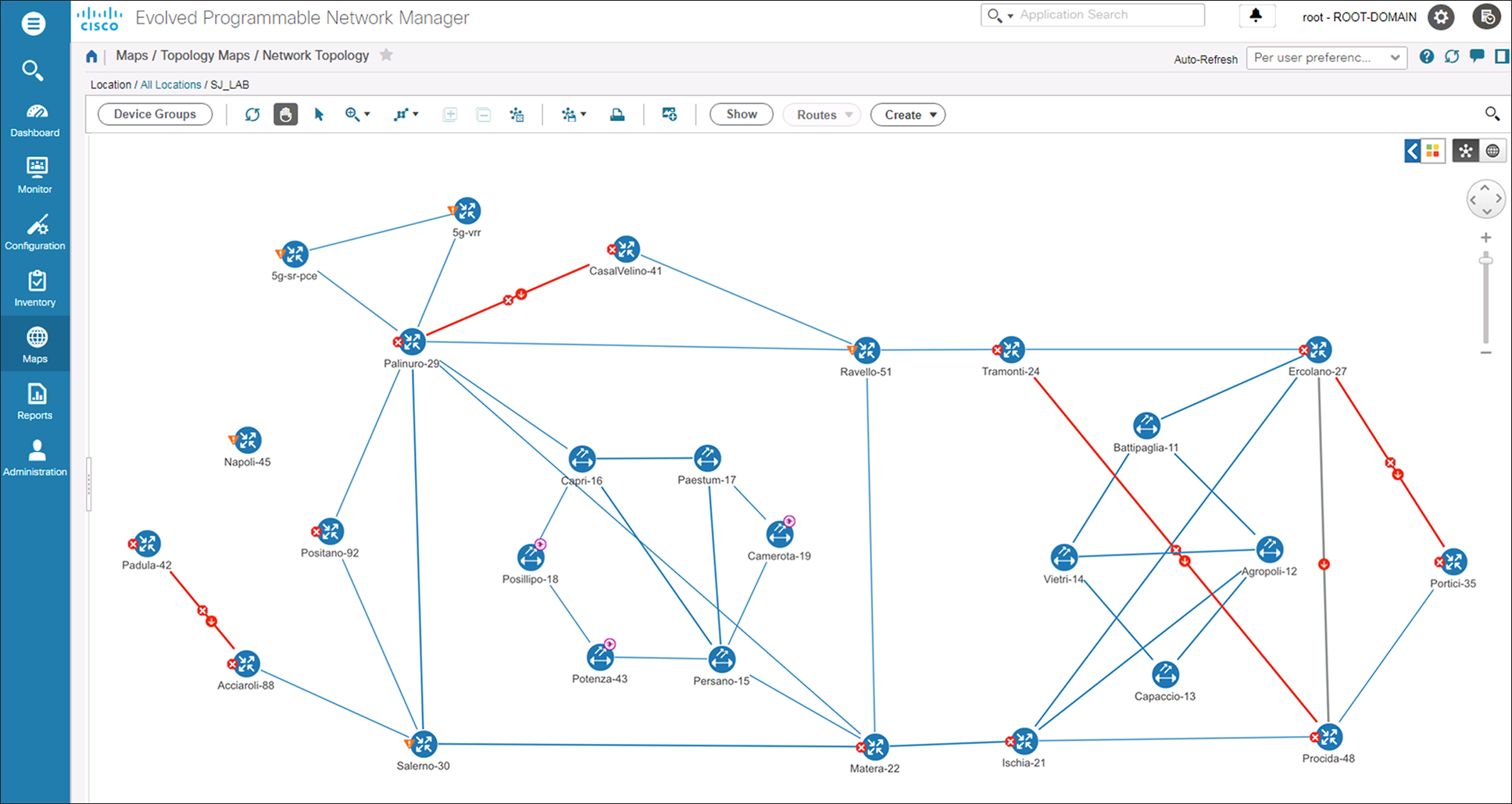
Logical network topology map
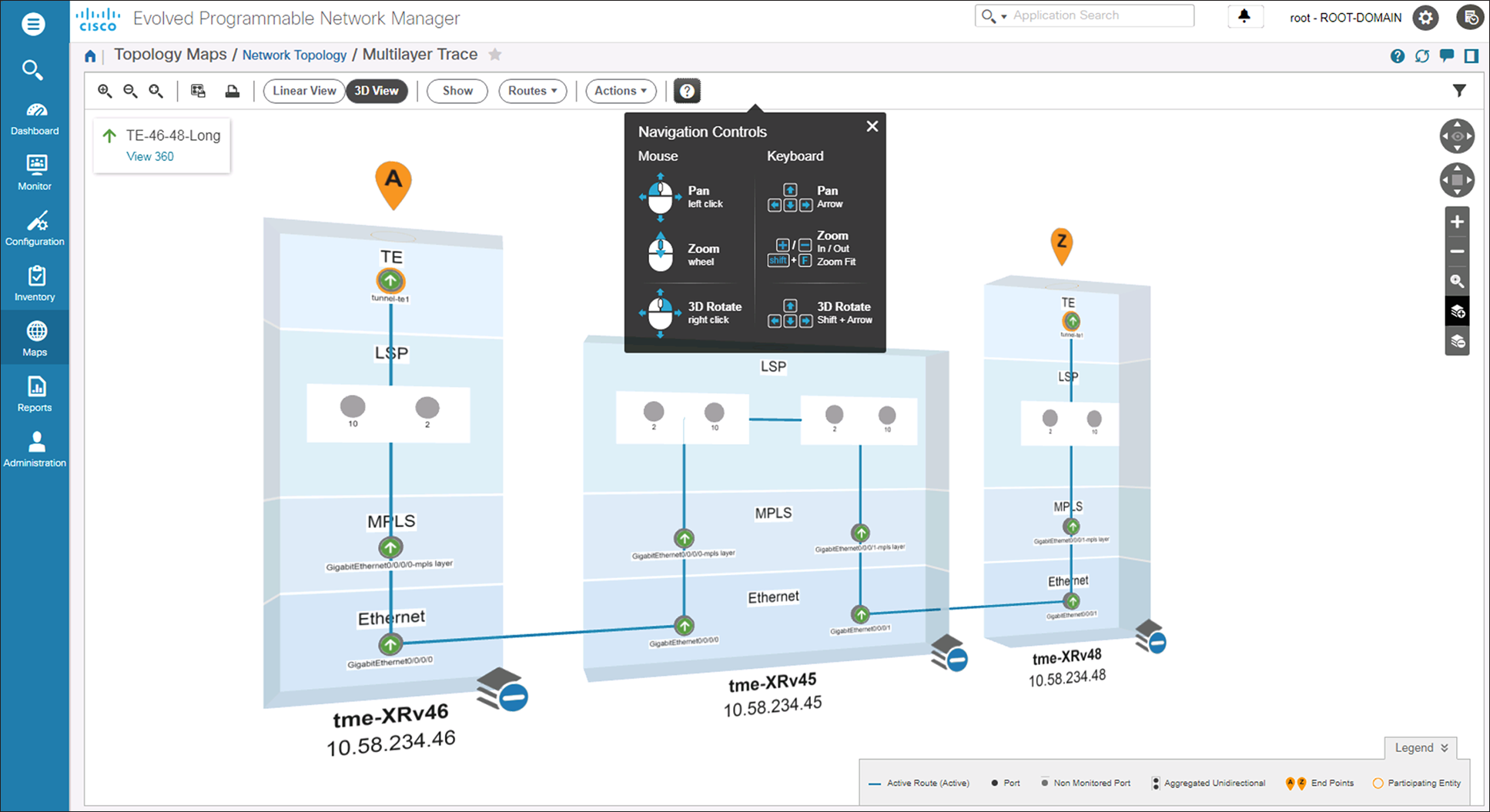
Cisco EPN Manager multilayer trace capabilities
Monitoring: The Cisco EPN Manager helps reduce the time to know about network- or service-affecting conditions by correlating raw events and associating alarm conditions with affected managed network elements, network connectivity, and network services. Contextual dashboards and 360-degree views (device and port levels) display the most relevant information for fast and efficient problem identification and remediation.
The configurable home screen of the EPN Manager can provide an at-a-glance view of the status of the network to help direct a network operator’s attention to key changes in the network.
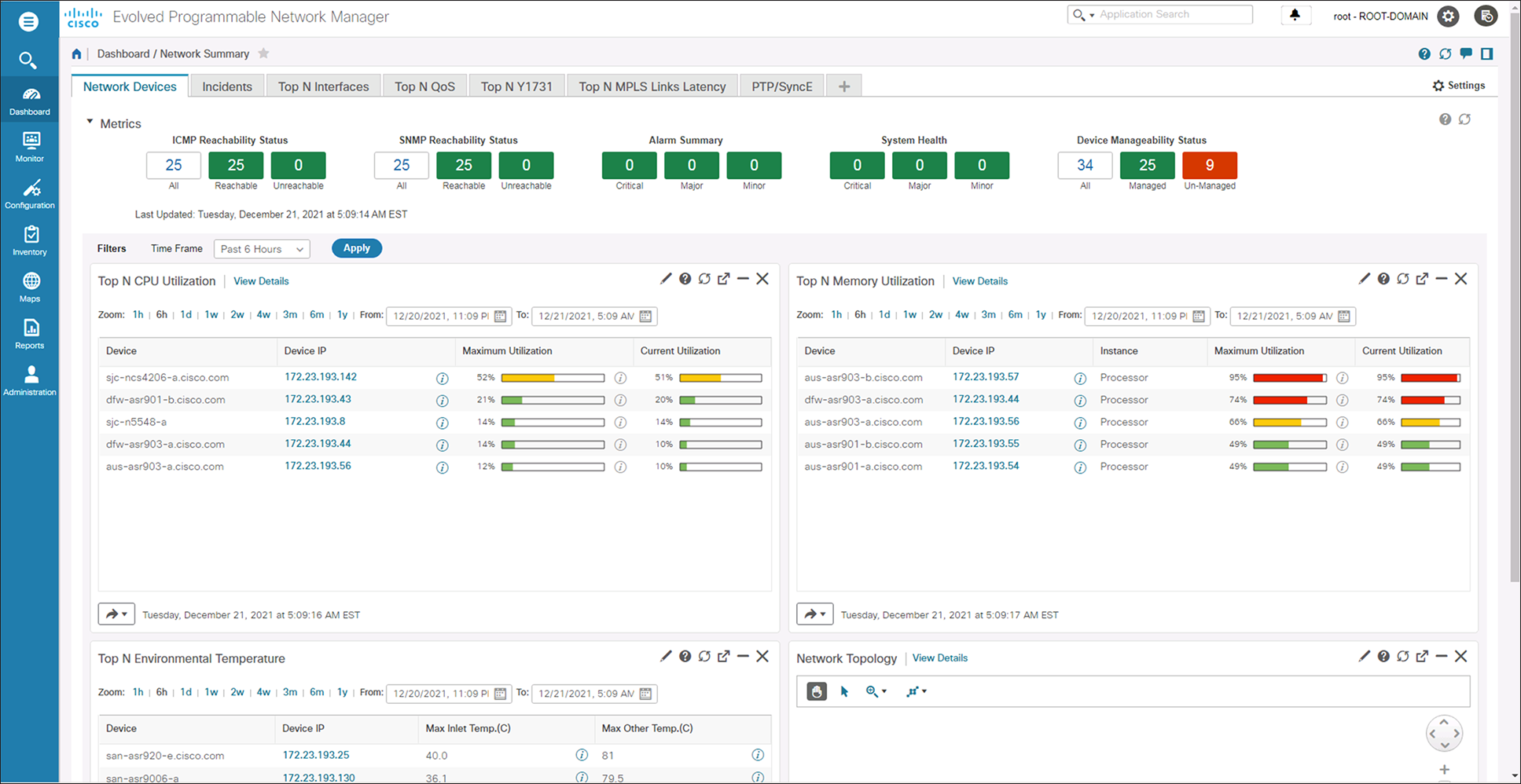
Cisco EPN Manager dashboard home screen
Another starting point for monitoring the network for key events is the alarm and event browser.
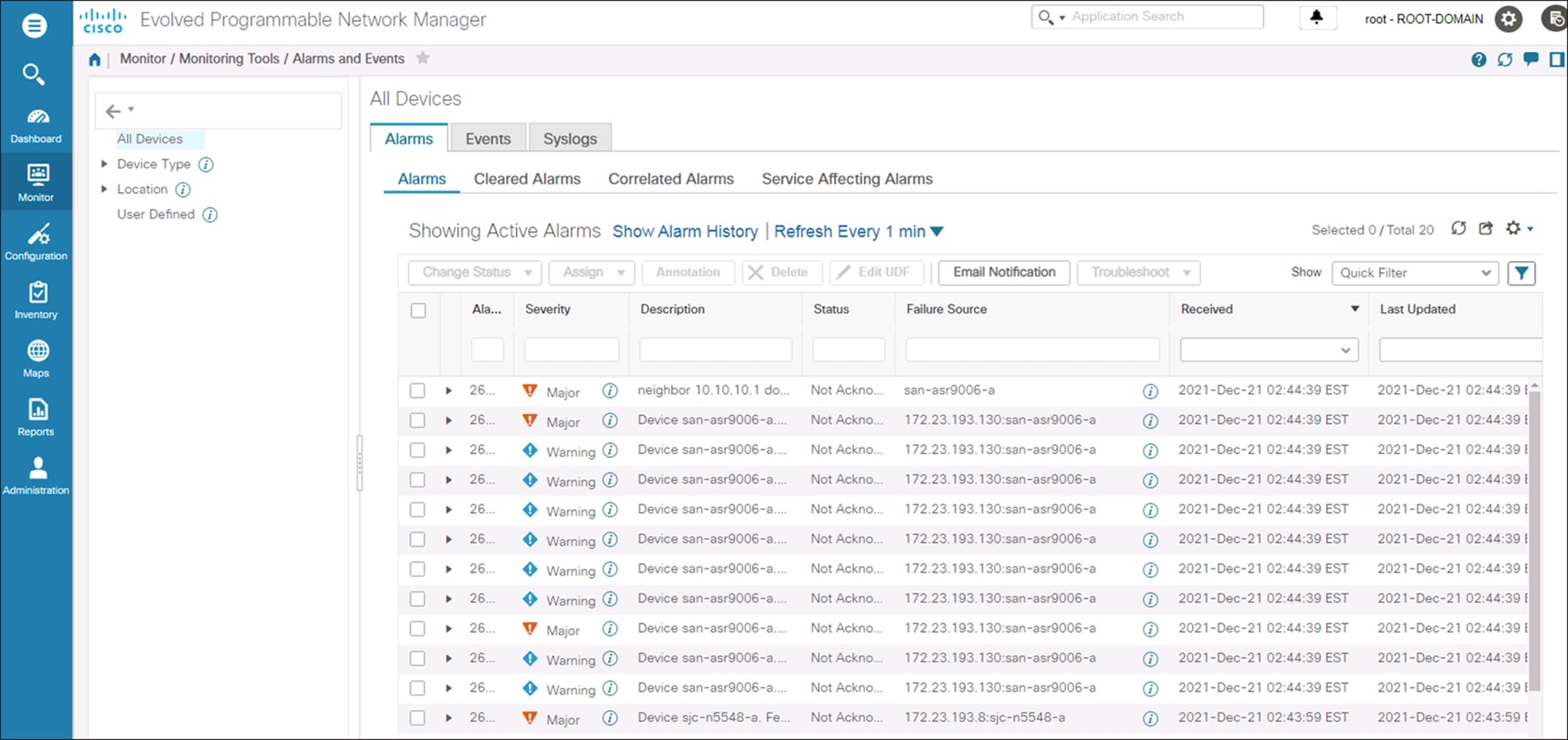
Cisco EPN Manager alarm and event browser
Once alerted, network operators can react quickly and accurately, guided by Cisco EPN Manager’s enriched alarm information and alarm overlays on chassis views and topology displays.
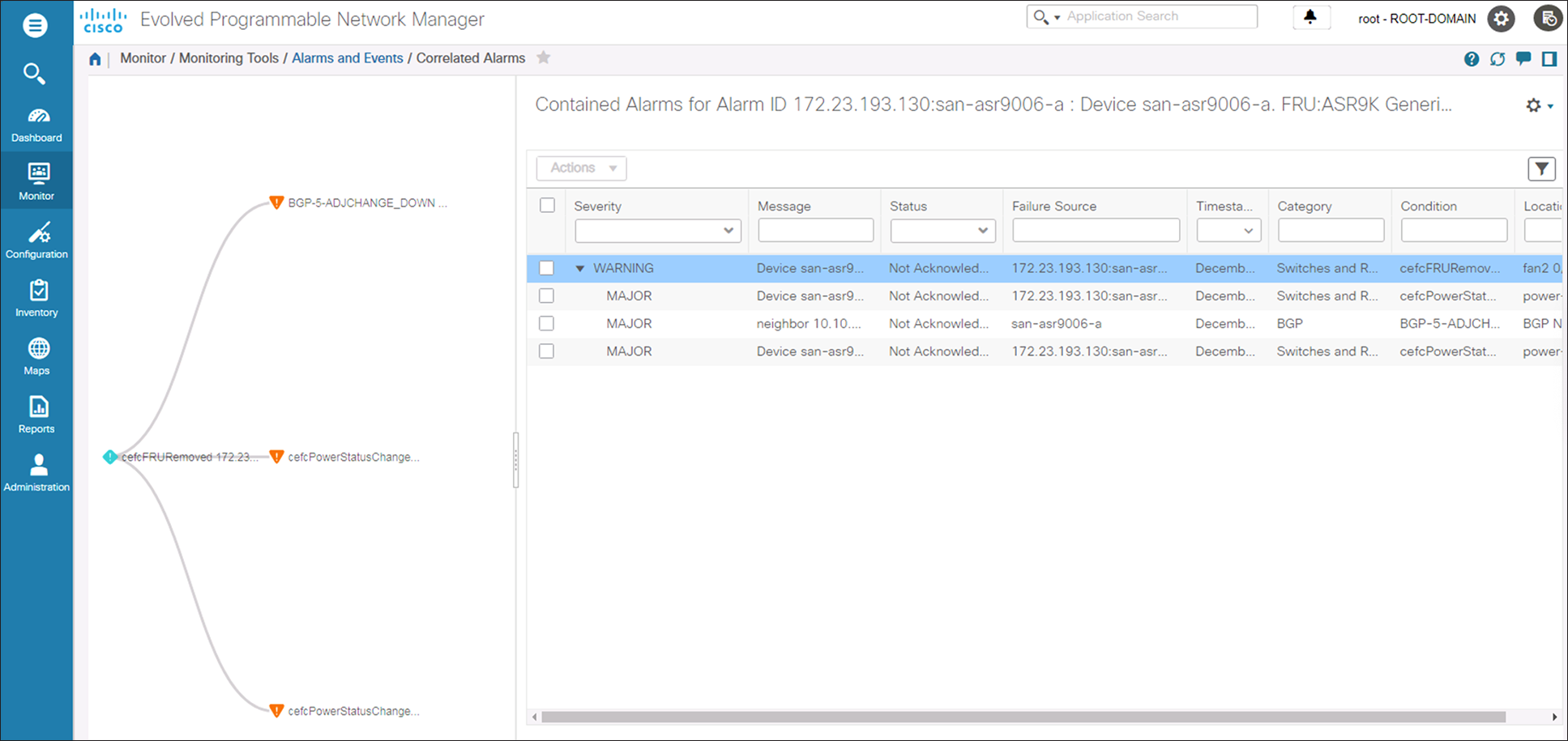
Alarm correlation view
Troubleshooting: To help reduce the time to restore and repair, the Cisco EPN Manager can guide the troubleshooting process via alarm correlation, identification of affected network components or services, and connectivity and service level tests (for example, Y.1564 and Y.1731 measures for Carrier Ethernet, IP SLA for Layer 3 VPN, OTDR tests for fiber paths, and OAM tools for MPLS connectivity).
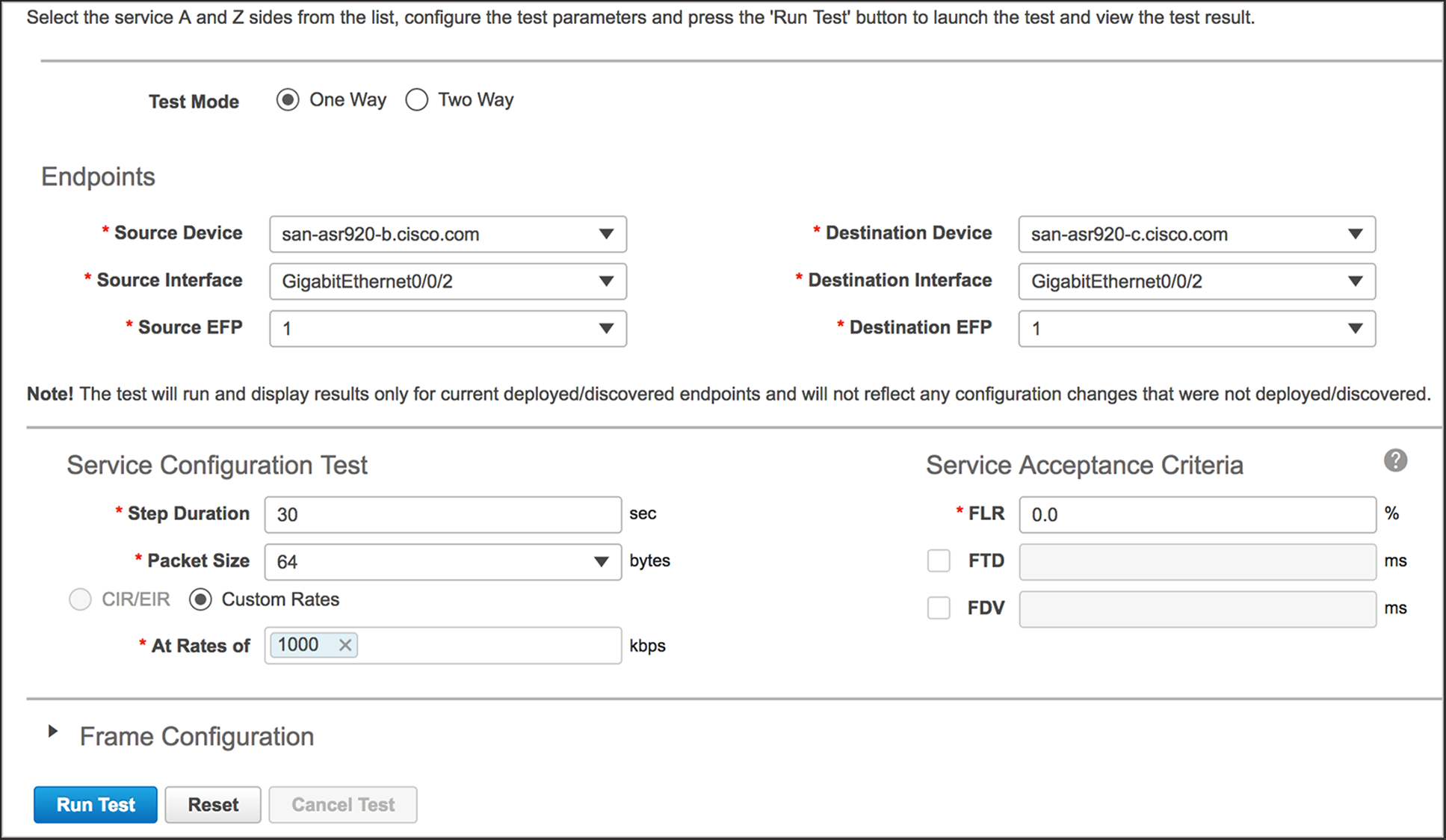
Cisco EPN Manager Carrier Ethernet service testing capabilities

Example of test results
Put into practice, the element and network function scope of the Cisco EPN Manager helps network operations:
● Reduce time to know and time to action through comprehensive monitoring capabilities
● Reduce mean time to repair through troubleshooting functions that leverage detailed network-resident data and functions
● Reduce mean time to value and increase configuration accuracy through graphical configuration features and provisioning wizards as well as a comprehensive RESTCONF API for integration with an external Operations Support System (OSS)
● Reduce time spent on routine, day-to-day tasks through a centralized graphical network administration user interface
● Extend “flow-through” operation through integration into existing OSS architectures via a comprehensive RESTCONF API
Northbound interfaces
RESTCONF
The EPN Manager implements the RESTCONF API as a standards-based northbound interface for integrating Cisco EPN Manager with a standards-compliant OSS. It is a set of REST services adopted to the RESTCONF/YANG specifications.
The EPN Manager implementation of the RESTCONF/YANG interface supports the retrieval of device inventory, circuit inventory, circuit provisioning, and notifications about respective resource changes and provisioning. This includes:
● Managed Elements and Equipment Inventory
● Termination Point and Topological Link Inventory
● Virtual Connection (RFS) Resource Inventory
● Service (CFS) Inventory
● Service Provisioning
● Inventory Object Create, Delete, and Attribute Value Change (AVC) Notifications
REST
The EPN Manager REST API is a language-independent interface that can be used by any program or script capable of making HTTP requests. The REST API can be used to retrieve Cisco EPN Manager reports on physical and virtual devices, networks, groups and users, policies, and other monitored entities within your Cisco EPN Manager domains.
SNMP
To integrate with SNMP-based Fault Manager of Managers, the EPN Manager can forward notifications in SNMPv2 or SNMPv3 format as specified via the CISCO-EPM-NOTIFICATION-MIB. Notifications can also be forwarded to email recipients. The EPN Manager forwards alarms and events that are generated by the processing of received syslogs, traps, and TL/1 alarms to a northbound notification receiver. Alarms of any severity can be forwarded.
Southbound interfaces
Several interfaces are used to collect and receive information from the managed network for various purposes. The foundation for element and network management is the inventory data that defines the managed devices and network connectivity. To collect inventory data, the EPN Manager uses combinations of protocols depending on the best interface methods supported by various network element types. These protocols include Command-Line Interface (CLI), SNMP, TL1, HTML, XML, and NETCONF. To discover connectivity among network elements, the EPN Manager leverages neighbor information collected by network elements via CDP or LLDP protocols or from neighbor information generated by the operation of various routing and forwarding protocols.
To keep network element and network connectivity updated, the EPN Manager leverages configuration change messages from the network as triggers for collecting specific data related to the reported change. Regularly scheduled network synch operations supplement the notification-based network inventory updates.
In order to monitor the network for status changes and alarm conditions, the EPN Manager uses autonomous events sent by network elements in the form of SNMP notifications/traps, syslog messages, and TL1 and NETCONF notifications. To complete the information about the state of the network, EPNM smartly and actively polls for physical and port status information plus periodically reconciles alarms with alarm and event data on network elements. The following figure illustrates the range of information collected from the network and the methods for data collection.
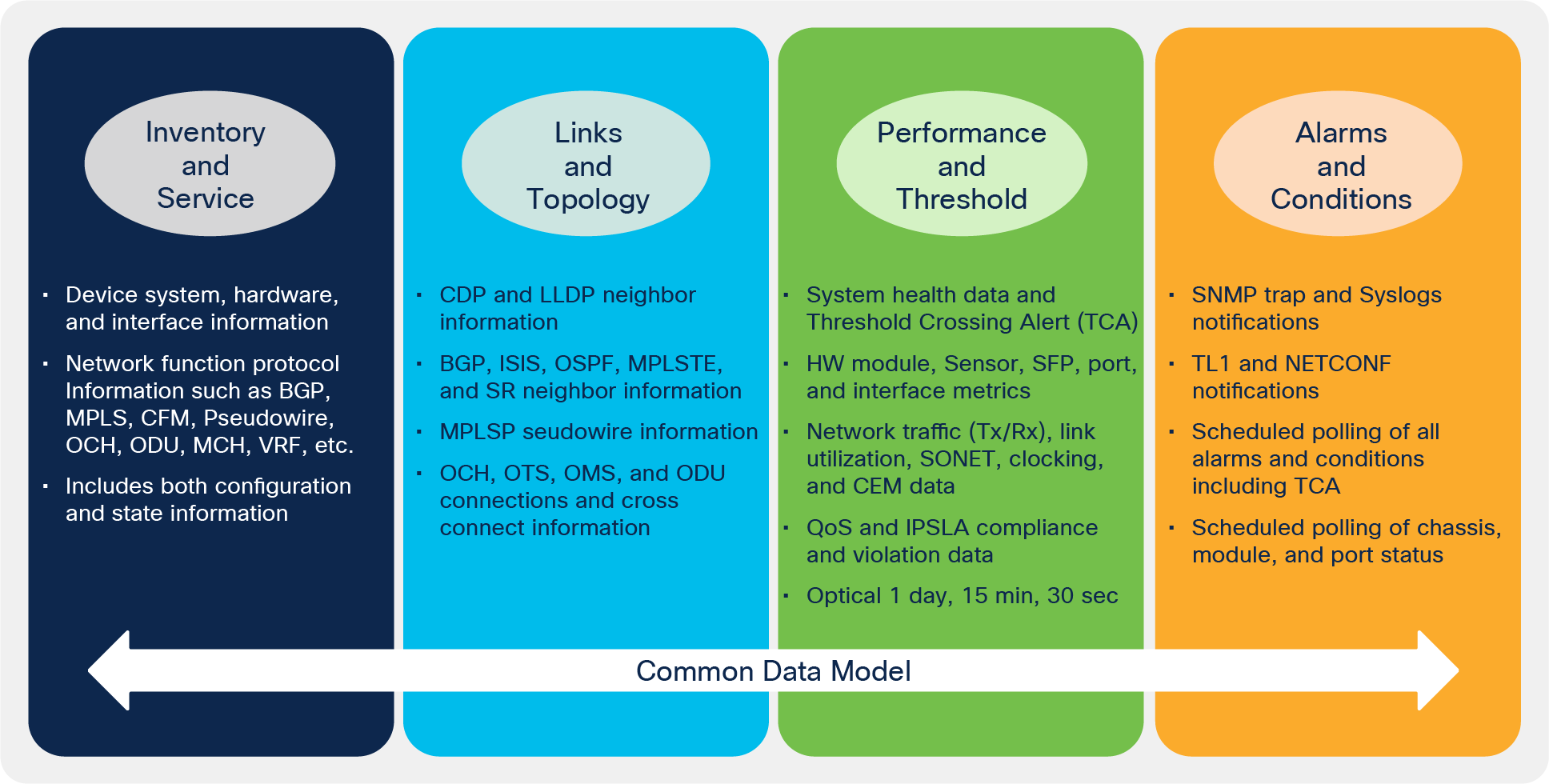
EPN Manager data collection
Tables 1 through 3 describe the Cisco EPN Manager features for each main network scenario/scope.
Table 1. DWDM, OTN and coherent optics Cisco Routed Optical Networking features
| Feature |
Description |
| Point-and-click provisioning of circuits |
● Fast, easy, and automated provisioning that uses a single platform and similar workflows to create optical transport circuits with different technologies: OTN switching, DWDM optical switching Common database shared between components
|
| Event and fault management for optical transport circuits |
● Graphical correlation of faults at different layers (OTN and DWDM) compatible to the Cisco Routed Optical Networking architecture
● Support for multilayer circuit trace
● Visualization of Optical circuits terminated on router Optics (e.g. 400G QDD-ZR)
|
| Network health monitoring, including fault and performance monitoring |
● Network health monitoring, including network-level alarms, performance metric gathering, and TCAs
● Per-circuit performance monitoring
● Monitoring of 400G QDD-ZR optical parameters
|
| Visually appealing user interface with ease of use for operators |
● Wizard-led interaction, network maps, circuit topology, point-and-click provisioning, circuit trace, device 360-degree view, port 360-degree view, and multilayer topology visualization of ODUxx and OCHxx circuits
|
| Chassis view |
● Display of images of the actual chassis and the modules that have been populated for the particular network element, including indicators for chassis-level and module-level alarms down to pluggable port optics level; multichassis nodes are shown on multiple tabs
|
| NBIs for OSS integration |
● Standards-based NBIs (REST, RESTCONF, SNMP) to integrate with third-party OSSs
|
Table 2. Carrier Ethernet and L3 VPN services features
| Feature |
Description |
| Point-and-click provisioning of services |
● Fast, easy, and automated provisioning that uses a single platform and similar workflows to create Layer 3 VPN connections, EVPN, Ethernet Virtual Connections (EVCs), and MEF 2.0 services
● Common database shared between components
● Provisioning and configuration of MEF 2.0 services (including Quality of Service [QoS], Layer 2 control protocol [L2CP], and Ethernet Operations, Administration, and Management [OAM] parameters) in a few clicks
● Support for services including E-LAN, E-LINE, E-TREE, E-ACCESS, and L3VPN
● Support for SR TE, MPLS TE and bidirectional MPLS FlexLSP
|
| Comprehensive workflow to provision services |
● Guided workflow that allows the user to set or modify all the required parameters to configure end-to-end Carrier Ethernet services
● Support for Multiprotocol Label Switching (MPLS) to the edge or Ethernet access layer (G.8032, ICCP-SM, etc.)
|
| Event and fault management for EVCs |
● Event and fault management for Carrier Ethernet, L3VPN, and circuit emulation services and underlying infrastructure (EVC), including event correlation
● Support for multilayer circuit trace
|
| Network health monitoring, including fault and performance monitoring |
● Network health monitoring, including network-level alarms, performance metrics, and TCAs
● Per-circuit performance monitoring
|
| Service testing interface |
● Integrated service testing feature that uses RFC 2544 and Y.1564 capabilities to validate service continuity and performance before delivering a service to production networks
|
| Visually appealing user interface with ease of use for operators |
● Wizard-led interaction, network maps, EVC topology, point-and-click provisioning, device 360-degree view, port 360-degree view, and multilayer topology visualization of EVCs
|
| Layer 3 VPN provisioning |
● Provisioning for full-mesh, hub-and-spoke, and combined hub-and-spoke and full-mesh topologies; provisioning includes configuration of QoS attributes
|
| Layer 3 VPN resource allocation |
● Resource allocation for Layer 3 VPN (L3VPN), including route targets, route distinguishers, bridge group virtual interface (BVI) and Bridge Domain Interface (BDI) instances, and IP addresses
|
| Layer 3 VPN fault management |
● Management of all potential faults (traps and syslog) in relation to L3VPN services, with alarms automatically attached to the service; alarms include interface-level alarms, IP Service-Level Agreement (SLA) alarms, and QoS alarms
|
| Chassis view |
● Display of images of the actual chassis and the modules that have been populated for the particular network element, including indicators for chassis-level and module-level alarms; multichassis nodes are shown on multiple tabs
|
| NBIs for OSS integration |
● Standards-based NBIs (REST, RESTCONF, SNMP) to integrate with third-party OSSs
|
Table 3. Circuit emulation over packet network features
| Feature |
Description |
| Discovery plus point-and-click provisioning of services |
● Fast, easy, and automated provisioning that uses a single platform and similar workflows to create Structure Agnostic Time Division Multiplexing over Pseudowire (SAToP) and Circuit Emulation Service over Packet Switched Network circuits (for example, DS1 or SONET circuits over Pseudowire tunnels)
● Creation and provisioning of CEM services on Cisco ASR 903, Cisco ASR 907, and Cisco NCS 42xx devices
● Support for SONET circuits with Unidirectional Path Switched Ring (UPSR) and Automatic Protection Switching (APS) protection mechanisms
|
| Network infrastructure configuration |
● Bidirectional TE tunnel and Layer 3 link creation (co-routed tunnels only)
● Support for creating MPLS TE service on Cisco NCS 4200, ASR 900, NCS 4000, and ASR 9000
● Support for constraint-based routing and trunk admission control
● Ability to choose the mechanism to protect the tunnel against link and node failures when provisioning an MPLS TE service
● Usage of Resource Reservation Protocol (RSVP) to establish and maintain Label-Switched Path (LSP)
● Ability to configure H-QoS to specify QoS behavior at multiple levels of hierarchy for Cisco NCS 4000 and 42xx devices
● Support for configuration of frequency synchronization using Sync-E and BITS
|
| Event and fault management for CEM circuits |
● Event and fault management for CEM services and underlying infrastructure (MPLS LSP, OTN), including event correlation
● Support for multilayer circuit trace
|
| Network health monitoring, including fault and performance monitoring |
● Network health monitoring, including network-level alarms, performance metrics, and TCAs
● Per-circuit performance monitoring
|
| Service testing interface |
● BERT testing to validate end-to-end continuity of circuit emulation services
|
| Chassis view |
● Display of images of the actual chassis and the modules that have been populated for the particular network element, including indicators for chassis-level and module-level alarms; multichassis nodes are shown on multiple tabs
|
| Visually appealing user interface with ease of use for operators |
● Wizard-led interaction, network maps, topology, point-and-click provisioning, device 360-degree view, port 360-degree view of CEM circuits
|
| NBIs for OSS integration |
● Standards-based NBIs (REST, RESTCONF, SNMP) to integrate with third-party OSSs
|
Tables 4 through 7 outline the product specifications for each Cisco EPN Manager component.
Table 4. Element and device management
| Specification |
Description |
| Optical transport network elements |
● Cisco ONS 15454 Multiservice Transport Platform (MSTP); and Cisco Network Convergence System (NCS) 1001, 1002, 1004, 2002, 2006, 2015, 4009, and 4016
|
| Circuit emulation nodes |
● Network Convergence System (NCS) 4201, 4202, 4206, and 4216 and ASR 900 Series
|
| Packet (L2/L3VPN) network elements |
● Cisco CRS, ASR 9000v, 9001, 9006, 9010, 9904, 9912, 9922, 901, 902, 903, 907 and 920 Routers; NCS 4000 and NCS 4200 Series; NCS 540/NC S560, NCS 55xx/NCS 57xx, and NCS 5000 Series
|
| Configuration compliance |
● With the addition of a compliance engine, EPN Manager provides operators with the ability to specify the golden network configuration and perform an audit of the network devices against the configuration archive or the device configuration. The audit report identifies devices that are out of compliance. Operators can remediate the devices that are out of compliance with the desired configuration. This engine also helps with generating reports for EoL/EoS/PCI for network devices.
|
| Software image management and configuration file management |
● Management of the configurations, including backup of the configurations in a centralized database
● Software download and activation: single and bulk
|
| Generic (any) device support |
● Basic support using standard SNMP MIBs
|
Table 5. Network assurance
| Specification |
Description |
| Discovery |
|
| End-to-end discovery of network configuration |
● Discovery with graphical overlay on topology map to quickly identify Layer 0 through 3 connections
|
| Fault association |
● Fault association to affected network services for rapid analysis of impact
|
| Summary view |
● Summary view displayed in the topology map for quick identification of connections in the selected region or logical group of devices
|
| Service 360-degree view |
● At-a-glance view of service performance
|
| Interface 360-degree view |
● Shows main port and interface attributes and metrics, including interface name, port address, operational and administrative status, highest alarm severity of currently active alarms, current alarms associated with the interface, and current events associated with the port
|
| Link 360-degree view |
● Shows link attributes, end points, faults, and circuits using the link
|
| Fault correlation |
|
| Graphical correlation of fault at multiple layers with different technologies |
● Complete and detailed view of the configuration change history of all devices in the network, enabling network operators to make informed decisions about unplanned changes and take appropriate action
|
| Events correlated to single root-cause alarm |
● Enables events to be traced back to a single root cause and displays the root-cause alarm; all events can be browsed, opening the details of the root-cause alarm
|
| Fiber cut geo localization |
● Embedded OTDR instrument on optical devices; real-time identification of fiber cut and fiber issues with geo localization
|
| Alarm management |
● Single dashboard for alarms coming from all the devices in the network
● Consolidation of traps and syslogs into alarms
● Graphical notification of alarms
● Alarm lifecycle management
|
| Alarm customization |
|
| Alarm definition customization |
● Ability to customize alarms based on the operational needs. Customizable syslog-based alarms provide the ability to custom create new alarms and prioritize operator response.
|
| Performance monitoring |
|
| Correlated performance graphs |
● Correlated charts enable operators to carry out comparative troubleshooting of network KPIs. The overlay of alarms and configuration change events in the correlated graphs helps connect network change events to performance degradation/improvements.
|
| Real-time performance test |
● Real-time performance data accessible for quick troubleshooting; optical physical performance and protocol error counters are available
|
| Multilayer trace |
|
| Graphical view of used resources |
● Graphic view of all the resources associated with a given connection; tracking includes the underlying layer, providing a powerful tool for root-cause analysis and impact analysis
|
| Multilayer fault correlation |
● Correlation of faults that may affect a connection at different layers
|
Table 6. Network provisioning
| Specification |
Description |
| Packet and CEM network service provisioning |
Consistent workflows based on a common platform. Wizard-driven provisioning for optical circuits, Carrier Ethernet, L3VPN, circuit emulation services, and MPLS tunnels. |
| Optical transport circuit provisioning |
● Fast, easy, and automated provisioning that uses a single platform and similar workflows to create Optical Transport Network (OTN) and Dense Wavelength-Division Multiplexing (DWDM) circuits
● Common database shared between components
● Optical circuits support for optical channel data units and optical channels (ODUxx and OCHxx)
|
| Topology automation |
Overlay visualization for provisioned services |
| Point-and-click operation |
Simplified provisioning directly from the network topology map |
Table 7. System integration and customization
| Specification |
Description |
| OSS integration |
● The RESTCONF/YANG API can be used to manage device and circuit inventory; to retrieve alarms and events; to perform scheduled job operations, including getting job summaries and histories, cancelling jobs, resuming and suspending jobs, and performing report operations; and to execute the Command-Line Interface (CLI) template.
● The REST API provides system information, most statistics and assurance information, configuration files, group management, and device import capabilities.
● The network management information model, defined in YANG and accessible via the RESTCONF interface, is based on TeleManagement Forum (TMF) standards governing the modeling of the physical and service inventory.
● Event notification service for forwarding notifications in SNMPv2 or SNMPv3 format as specified via the CISCO-EPM-NOTIFICATION-MIB. Notifications can also be forwarded to email recipients.
|
Cisco EPN Manager is offered as a prepackaged Open Virtual Appliance (OVA) for VMware. For more detailed information about system requirements and technical specifications, refer to the EPN Manager Installation Guide at https://www.cisco.com/go/epn-manager/.
The Cisco EPN Manager high-availability framework helps ensure continued system operation in the event of failure. High availability is achieved through a pair of linked, synchronized EPN Manager servers to reduce or eliminate the impact of application or hardware failures that may occur on either server.
Cisco EPN Manager supports Smart Licensing by establishing a pool of software licenses or entitlements in a customer-defined Cisco Smart Account. The Smart Account provides a central location where you can view, store, and manage your licenses. Association of the licenses to the Smart Account is mandatory before the customer can successfully license their products. Smart Licensing delivers visibility into your license ownership and consumption.
The top-level product ID for the Cisco EPN Manager is R-CISCO-S-EPNM-K9.
Refer to Cisco Smart Licensing for more information.
For more information on converting from traditional licensing to Smart Licensing, please refer to Convert Classic Licenses to Smart Licenses (video).
Pricing for the Cisco EPN Manager, starting with release 3.0, is divided into a perpetual license component and a Software Innovation Access (SIA) subscription component.
Cisco EPN Manager is also available packaged in two suite options with Cisco Crosswork Essentials and Cisco Crosswork Advantage. These suites provide the advantage of lower licensing costs than if you purchase Crosswork tools individually. Please see the Crosswork Essentials and Advantage Data Sheet for more details
For more information on ordering and pricing, please contact a Cisco sales representative.
The Cisco EPN Manager follows the standard 90-day limited liability warranty. For more information, please see WARR-90-DAY-SW-TS.
Cisco offers a wide range of service programs to accelerate customer success. These innovative service programs are delivered through a unique combination of people, processes, tools, and partners, resulting in high levels of customer satisfaction. Cisco Services help you protect your network investment, optimize network operations, and prepare the network for new applications to extend network intelligence and the power of your business. For more information, visit the Cisco Software Support page on Cisco.com.
Flexible payment solutions to help you achieve your objectives
Cisco Capital makes it easier to get the right technology to achieve your objectives, enable business transformation and help you stay competitive. We can help you reduce the total cost of ownership, conserve capital, and accelerate growth. In more than 100 countries, our flexible payment solutions can help you acquire hardware, software, services and complementary third-party equipment in easy, predictable payments. Learn more.
For more information about Cisco EPN Manager, please visit https://www.cisco.com/go/epn-manager, contact your local account representative.
| New or Revised Topic |
Described In |
Date |
| Added Cisco EPN Manager features for routed optical networking |
Product Specifications |
May 5, 2021 |
| Updated Content |
All Sections |
July 15, 2020 |
| Updated Figures and Screenshots |
All Sections |
January 15, 2020 |